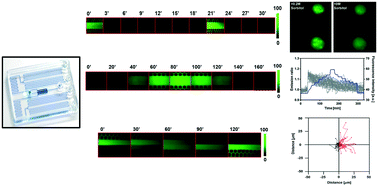High-throughput injection molded microfluidic device for single-cell analysis of spatiotemporal dynamics†
Abstract
Single-cell level analysis of various cellular behaviors has been aided by recent developments in microfluidic technology. Polydimethylsiloxane (PDMS)-based microfluidic devices have been widely used to elucidate cell differentiation and migration under spatiotemporal stimulation. However, microfluidic devices fabricated with PDMS have inherent limitations due to material issues and non-scalable fabrication process. In this study, we designed and fabricated an injection molded microfluidic device that enables real-time chemical profile control. This device is made of polystyrene (PS), engineered with channel dimensions optimized for injection molding to achieve functionality and compatibility with single cell observation. We demonstrated the spatiotemporal dynamics in the device with computational simulation and experiments. In temporal dynamics, we observed extracellular signal-regulated kinase (ERK) activation of PC12 cells by stimulating the cells with growth factors (GFs). Also, we confirmed yes-associated protein (YAP) phase separation of HEK293 cells under stimulation using sorbitol. In spatial dynamics, we observed the migration of NIH 3T3 cells (transfected with Lifeact-GFP) under different spatiotemporal stimulations of PDGF. Using the injection molded plastic devices, we obtained comprehensive data more easily than before while using less time compared to previous PDMS models. This easy-to-use plastic microfluidic device promises to open a new approach for investigating the mechanisms of cell behavior at the single-cell level.



 Please wait while we load your content...
Please wait while we load your content...